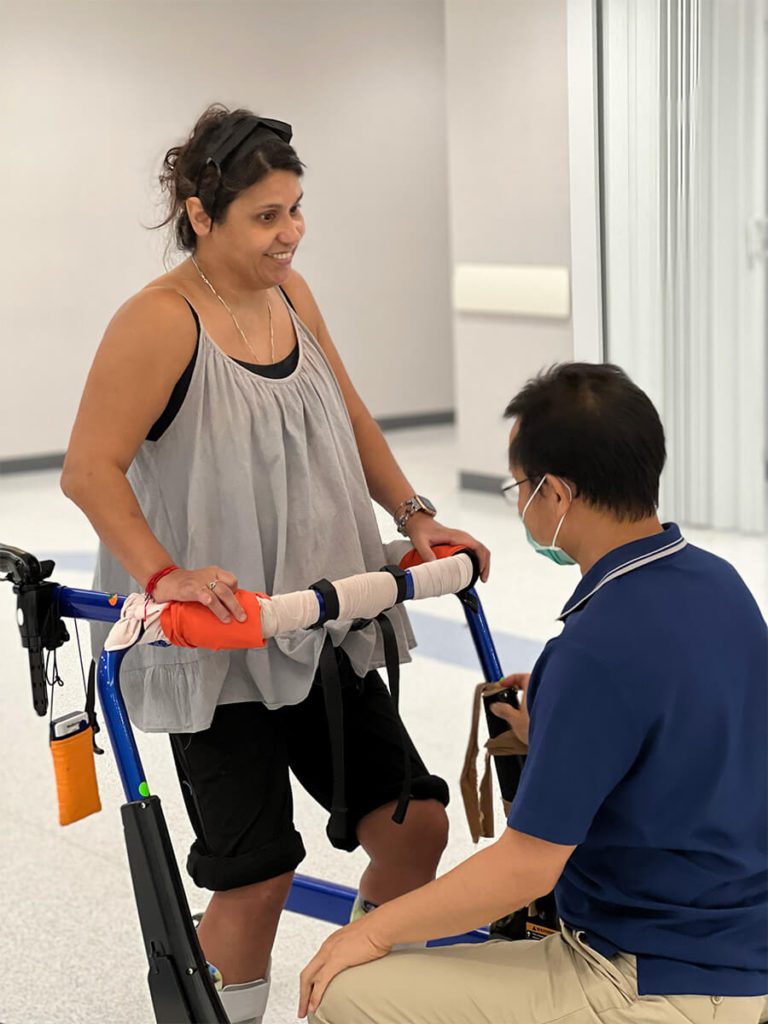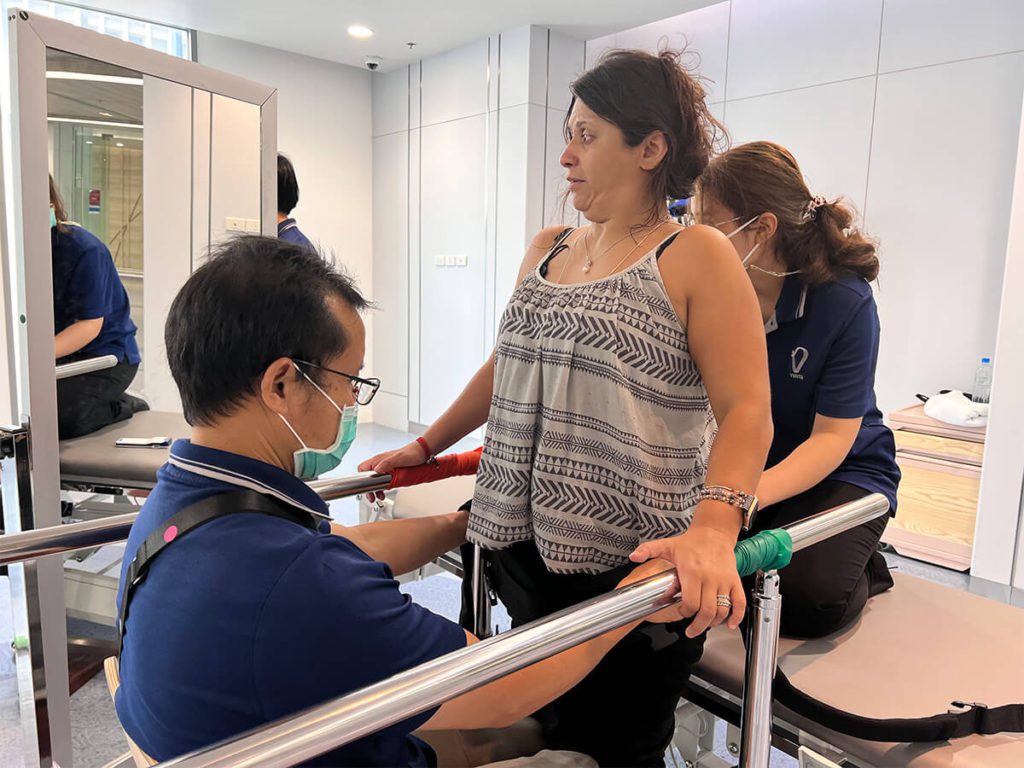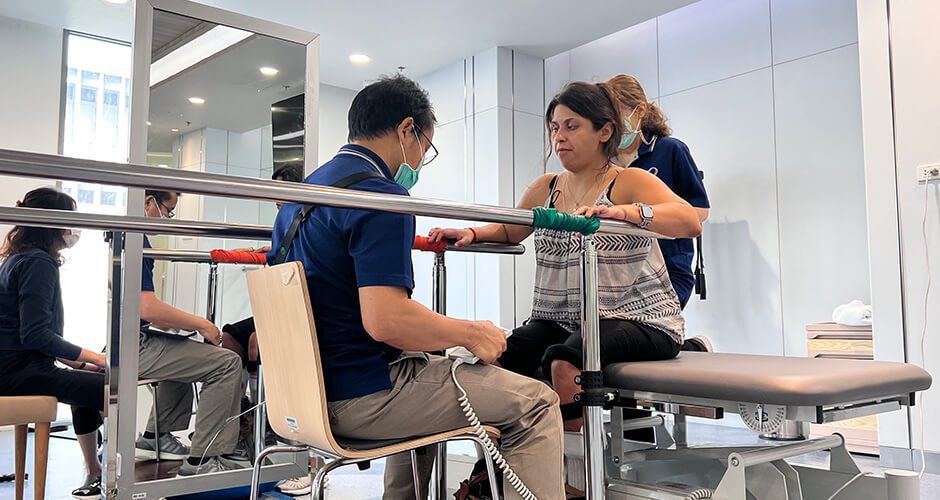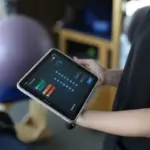It is estimated that around 65% of spinal cord injury patients experience incomplete spinal cord injuries. The impact of an incomplete spinal cord injury is somewhat different from a complete injury. The American Spinal Injury Association uses a grading system to define these differences. Karla’s injury is defined as an ‘ASIA C’ injury, meaning that “Motor function is preserved below the neurological level, and more than half of key muscles below the neurological level have a muscle grade less than 3”. Essentially, this means incomplete spinal cord injury patients usually retain some level of sensory and/or motor function below their injury level. Epidural stimulation can be especially effective for these patients, and Dr. Nasir spoke to Karla about her experiences and the benefits which she saw from her treatment.
Please could you introduce yourself?
So since your injury in 2002, what kind of changes did you see before you came for treatment with Verita Neuro?
Did you get any major procedure apart from physiotherapy prior to your epidural stimulation treatment?
Karla so what was your initial experience? How did the surgery go and what did you feel during the post-operative recovery?
For me, it’s different because I have sensation, because my diagnosis is incomplete spinal cord injury. That’s why it’s hard for me to explain this because I could feel – I felt the electricity. It was surprising, I guess, just to see the legs kind of do their little movements. The feeling was surprising because I didn’t expect to feel the stim the way I did. It was interesting when it started, I was very impressed and looking forward to doing the treatment. I was a little bit nervous because I knew what to expect but when someone’s telling you it’s different from when you actually go through it. Luckily I had very good therapists – everybody is very, very nice and patient with me.

The most important part of the treatment after the implantation is mapping (tailoring the stimulator to your body). What was your experience in terms of mapping?
No problem! People would also like to know about your stem cell treatment.
So the doctor would do the injection and then you spend I think six or seven hours lying on your back. It wasn’t bad, it wasn’t anything. The only thing I notice is that you do feel a bit of burning sensation and tingling and eventually a little bit more spasming, but the stem cell treatment part was not significant. It was more afterward, you start to feel more spasms and little things that happen afterward. But during the actual stem cell part, it’s easy.
Maybe you can share a little bit more about the changes you saw? Can you tell us a little bit more about your initial recovery period and the first movements you saw coming back?
At first one leg, I think my right leg, was stronger than my left leg. The left leg took time to start lifting but then eventually I was able to use the stationary bike. Just to be able to do that was very impressive. I wasn’t expecting that. Then I could stand up and take some steps with the stim and be able to see my knees lift. In the past when I’ve had KAFOs (knee-ankle-foot-orthoses) you’re just kind of pulling your leg and doing a bit of lift, but with epidural stimulation, to feel your knee going up and going back down I wasn’t expecting that. So that was pretty incredible. I think my sensation improved. It was really impressive. I know I’m using the word impressive a lot but it really was.

That’s great. Since you've been discharged from the hospital, which is I believe I was six months ago, how are you doing?
I do the bike program, I do the stepping program. I have the walking frame for that and I have a treadmill. I go to physiotherapy but mainly my exercise is here with my personal trainer and my dad. A lot of the stepping program is actually outside right now and doing the exercises there. So I’ve been able to follow the program and do more, just because there have continued to be improvements, so we’re trying to work with those improvements and combine them with the Verita Neuro program. So I think it’s been actually really easy to follow the program.
So maybe you can elaborate - let's start with maybe your walking and stepping. What can you do? What are some of the limitations you're facing?
The only limitation is that I spasm more, so I have to stop and really relax to stop it. I’ve had a lot of improvements with the walking. On the bike I can push the pedal. I need a bit of assistance for the last little bit, but I’m able to push and do a full circle. Right now, I’m learning how to pedal backward for the hamstring but it’s still very hard because it requires a lot of that muscle. My core is improved and I’m able to do a bit more of the bridge by myself. Someone helps me lift up and then I can hold for a little bit by myself. Maybe only a few seconds and then I have to let go so that’s been an improvement. I’m also able to lock my knees for long periods.
Have there been improvements to your cardiovascular function or your other autonomic functions?
In terms of bladder and bowel function I’ve always been able to feel when I have to pee, I’ve always had that sensation. I’ve been able to start holding it in – when I was in Thailand, I had to pee during the walk, I would wait 20 minutes just to see if I could hold it in, so I can hold it in longer as I guess. My bowels are the same thing, I’ve always been able to feel when I have to go. But in terms of actual motor, like being able to go to the bathroom, no, I require catheters and stuff.
So would you like to tell us a little bit more about your functions which you're able to do, even when the stimulators are turned off?
My therapist can feel the contraction and said that she knew when I’m going to move my leg because my toes curl first. That’s because I’m trying to focus so my toes will curl. With the right side, I’m also able to control when I do the push, I can control the knee locking. So now I could do the push, extending my leg, and I can do a kick without the stim. When I do the I’m standing up and lifting my knee exercises, I no longer use the program for the knee lift, I just use the spasm program to stop the spasming. So it’s been good.
So do you have any message for complete or incomplete spinal cord injury patients who are listening to you?
The above is not a verbatim transcript of Karla’s interview and the exact wording and order of words has been edited to be read more easily. You can watch the full interview on our YouTube channel.
References
- Spinal cord team. “Spinal Cord Injury – Types of Injury, Diagnosis and Treatment.” American Association of Neurological Surgeons, 11 February 2020. Accessed 18 July 2022
- Roberts, Timothy T et al. “Classifications In Brief: American Spinal Injury Association (ASIA) Impairment Scale.” Clinical orthopaedics and related research vol. 475,5 (2017): 1499-1504. doi:10.1007/s11999-016-5133-4. Accessed 18 July 2022.





